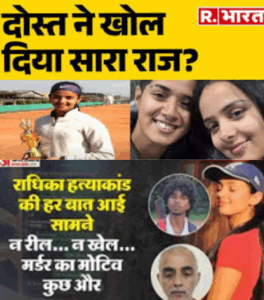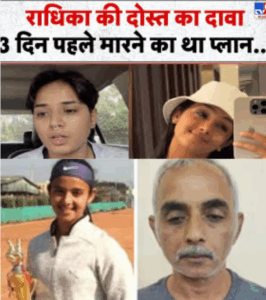Radhika Murder Case: Radhika’s friend Himanshika reveals the secret of the murder, what did she say about the family?
The tragic murder of Radhika Yadav has sent shockwaves across the nation, not only because of the brutality of the act but also due to the layers of complexity and controversy that surround the case. As new revelations come to light, particularly through the statements of Radhika’s closest friend, Himanshika Singh, the narrative has shifted from initial speculations to a deeper, more troubling story of family dynamics, societal pressure, and the consequences of extreme control.
Radhika Yadav was not just another young woman with dreams; she was a dedicated tennis player, a passionate individual who had been associated with the sport for 18 years. Her commitment to tennis was evident in her daily routine and her participation in numerous tournaments, many of which she attended alongside her friend Himanshika. Their friendship blossomed through shared experiences on and off the court, and together, they navigated the challenges and triumphs of competitive sports. Yet, behind Radhika’s achievements and cheerful demeanor, there existed a world of restrictions and surveillance imposed by her own family.
According to Himanshika, Radhika’s family was extremely orthodox, imposing strict rules that dictated every aspect of her life. She was given a fixed time to return home, her mobile phone was constantly monitored, and she was required to account for every action and interaction. Even casual video calls with friends were scrutinized, and any deviation from the established norms was met with suspicion and reprimand. This environment of relentless oversight left little room for personal freedom or self-expression, casting a long shadow over Radhika’s otherwise bright and promising life.

The most shocking revelation from Himanshika’s account is the claim that the plan to murder Radhika was in motion for three days before the incident. Allegedly, Radhika’s father, Deepak Yadav, orchestrated the circumstances by sending his wife, son, and even the family dog out of the house, ensuring that nothing would interfere with his grim intentions. The premeditated nature of the crime has raised disturbing questions about the level of control and resentment that may have been simmering within the family, as well as the extent to which Radhika’s autonomy was curtailed.
In the aftermath of the murder, public discourse quickly latched onto the possibility of a “love jihad” angle, a term often used in India to describe alleged cases where women are coerced into relationships or conversions by men of another religion. However, Himanshika has vehemently dismissed these claims as baseless and nonsensical. She asserts that Radhika’s life was not marked by any such relationship or controversy; instead, the real issue was the suffocating environment created by her family’s rigid beliefs and constant interference.
Himanshika’s statements have provided crucial insights into Radhika’s character and aspirations. She describes Radhika as someone who loved making music videos, clicking photos, and enjoying every moment of life. A video of Radhika, shot about a year and a half ago, recently resurfaced on social media, showcasing her zest for creativity and her willingness to seek her father’s permission for even the simplest of joys. This glimpse into her life paints a picture of a young woman striving to balance her passions with the constraints imposed upon her by her family.
Radhika was also a beloved coach, admired by her students for her dedication and positive attitude. Her influence extended beyond her own achievements, as she inspired others to pursue excellence in tennis and to find joy in the game. Yet, even as she built meaningful relationships outside her home, the pressure from her family remained a constant, unyielding presence. Himanshika recalls how Radhika was always under scrutiny, her parents obsessed with the fear of “what people would say.” This preoccupation with societal opinion, coupled with the relentless enforcement of rules, created an environment where Radhika’s individuality was stifled.

The murder itself was a culmination of years of tension and control. On that fateful Thursday, Deepak Yadav shot and killed his own daughter, an act that has left the community reeling and searching for answers. The accused father has since been placed in judicial custody for 14 days, but the questions raised by the case go far beyond the immediate legal proceedings. Why did it come to this? How did a family’s desire for control escalate into such a horrific act? Could the outcome have been different if Radhika had been allowed more freedom and support?
Himanshika’s testimony has opened up a broader conversation about the impact of family pressure and societal expectations on young women in India. The case is a stark reminder of the dangers of extreme orthodoxy and the psychological toll it can take on individuals who are denied agency over their own lives. It also highlights the importance of recognizing the signs of distress and providing support to those who may be struggling under the weight of parental or societal control.
The narrative surrounding Radhika’s murder has also been shaped by the media and public reaction. The rush to attribute her death to “love jihad” reflects a tendency to seek sensational explanations rather than confronting the more uncomfortable reality of domestic abuse and patriarchal control. By shifting the focus away from external factors and acknowledging the internal dynamics at play, Himanshika’s account challenges society to look inward and address the root causes of such tragedies.
As the investigation continues, the spotlight remains on the unanswered questions that linger over Radhika’s death. Was her murder solely the result of her father’s actions, or were there deeper issues within the family that contributed to the tragedy? How can society prevent similar incidents in the future? What role should schools, sports academies, and peer networks play in supporting young women who may be at risk?

The case has also prompted discussions about the need for greater awareness and intervention in situations where family pressure becomes oppressive. Mental health professionals, educators, and community leaders have a role to play in identifying signs of distress and offering resources to those in need. Empowering young women to speak out and seek help is essential, as is fostering an environment where individuality and self-expression are valued rather than suppressed.
In remembering Radhika Yadav, it is important to honor her legacy as a talented athlete, a dedicated coach, and a vibrant individual whose life was cut short by circumstances beyond her control. Her story serves as a sobering reminder of the consequences of unchecked authority and the urgent need for change in how families and society at large approach issues of autonomy, gender, and personal freedom.
Ultimately, the Radhika Yadav murder case is not just a story of one family’s tragedy; it is a reflection of broader societal challenges that demand collective introspection and action. As more details emerge and the legal process unfolds, it is imperative that the focus remains on seeking justice for Radhika and ensuring that her death becomes a catalyst for meaningful change. Only by addressing the underlying issues of control, pressure, and the denial of agency can we hope to prevent such tragedies in the future and create a society where every individual is free to pursue their dreams without fear or constraint.
Play video :
News
Humaira Asghar’s Postmortrm Report revealed shocking Truth of her Father on her LAST Audio Record!
Humaira Asghar’s Postmortrm Report revealed shocking Truth of her Father on her LAST Audio Record! . . . The Shocking…
Kareena Kapoor badly Attacked & met with an Accident after Saif Ali Khan Attacked !
Kareena Kapoor badly Attacked & met with an Accident after Saif Ali Khan Attacked ! . . . Kareena Kapoor…
Humaira Asghar’s Shocking Postmortrm Report revealed Truth of her Death after her LAST Voice Note!
Humaira Asghar’s Shocking Postmortrm Report revealed Truth of her Death after her LAST Voice Note! The world of entertainment is…
Husband and wife and those 3 actors will come in Bigg Boss 19, superstar BB opened his vault
Husband and wife and those 3 actors will come in Bigg Boss 19, superstar BB opened his vault As the…
Why was Abdu Rozik accused of theft? You will be shocked to hear the real truth of his arrest
Why was Abdu Rozik accused of theft? You will be shocked to hear the real truth of his arrest In…
Tragedy in Karachi: The Lonely Demise of Humera Asgar and the Entertainment Industry’s Wake-Up Call
Tragedy in Karachi: The Lonely Demise of Humera Asgar and the Entertainment Industry’s Wake-Up Call Karachi, July 2025 — The…
End of content
No more pages to load











